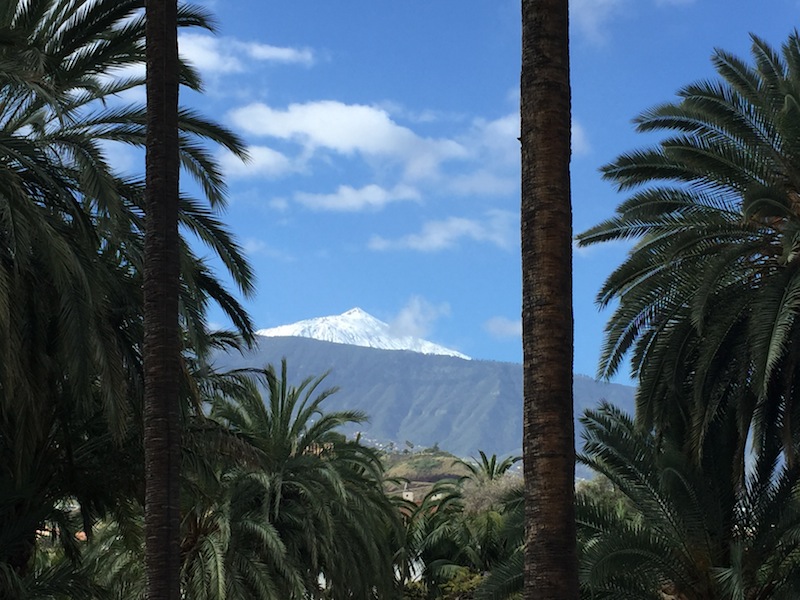When the clouds weren’t hovering threateningly over Tenerife we couldn’t miss the island’s magnificent volcano, Mount Teide.
Descending from 35,000ft in our Airbus on that first day, we saw it dominating the island that it helped to create, its upper slopes covered in snow. And from our hotel grounds in the resort town of Puerto de la Cruz, its perfect cone peaked out tantalisingly over the nearby hills.

A visit to Teide and its national park – a UNESCO World Heritage Site – was high on my admittedly short to-do list for Tenerife, and after days of cloudy weather we were assured by a friendly hotel receptionist that the roads would be open and visibility good beyond the layer of murk that hung over the peaks around our resort.
The drive to Teide wasn’t something I was looking forward to. We were going from sea level to 2,356m above it, to the base of the cable car that would then whisk us to the very top. But I had no idea how good the roads were.

We quickly got an indication of just how tough they could be when our annoying sat-nav took us into the back streets of La Oratava just a few miles from home, and on to a hill so steep that our little Citroen C1’s engine eventually gave up even trying and conked out. Once free of that predicament we never stopped climbing, through drab villages and the pine forests that cloaked the hills and were clearly a popular stop with hikers. But Teide was maddeningly elusive through the haze.
Soon we came across the snow and it grew deeper the higher we climbed. The sun broke through and we caught glimpses of Teide’s cone as the landscape changed from forest to fields of ice and snow broken up by jagged volcanic rocks, way above the tree line.

The queues at the cable car station were nowhere near as bad as I’d been led to expect so we were quickly climbing up the face of the volcano to the top station at 3,555m. At 27 euros a person, it wasn’t a cheap ride! It was bloody cold and thick with snow away from the viewing platforms at the peak, which disappointingly meant we couldn’t go for a walk. The top of the cone lay just out of reach.
In the thin air, which left me breathless, we did get to enjoy the gobsmacking views. From up top we could see that Teide sits within an amphitheatre, the Las Canadas caldera. In effect, we were sitting within a much more massive volcanic crater created something like 200,000 years ago, carpeted with ancient lava flows and all manner of material that had been ejected from the guts of the earth over millennia. It must’ve been a big bang… Beyond the crater lay the mountains that marked the boundary of the caldera.

And then, as we descended in our rammed cable car and I was beginning to think our visit was proving to be a bit disappointing, we spotted some jagged rock formations in the near distance. These turned out to be the Roques de Garcia and we drove out to them to explore, helped by the fact that on this side of the mountain there was little snow. But it was a popular stop. Cars and coaches lined the roads and we were lucky to find a parking space.
It was easy to see why it was popular. The landscape looked other worldly, like something from an alien Doctor Who planet. The giant rocks thrusting out of the ground have been much eroded over time and stand in stark contrast to the relatively smooth ground around. The most startling of the formations is the red rock called Cinchado, heavily eroded at its base, looking top heavy and precarious. In time, it will topple.

We walked into the wilderness, following a simple track, the rocks to our left and majestic Teide ahead of us. The sun came out and the land came to life, surprisingly colourful. Green vegetation – ferns, wallflowers, brooms and so on – hugged the ground, no doubt much oppressed by the winds, while the rocks were a vibrant mix of greys, reds, browns and black. Waves of smooth lava, frozen in time, contrasted with basalt, pumice and rocks that were as sharp as razor blades.
There were a fair number of hikers out there in the old crater but it was tiring stuff in thin air and we decided against doing a full circle, mainly because the final stretch would’ve involved quite a climb uphill back to the car. So we turned back.
We headed instead for the Parador Hotel nearby, standing lonely amid the volcanic park and doubtless an eerie place to stay in bad weather.
We had a bite to eat in the cafe while the sun shone, before driving home – downhill – amid traffic that was a lot heavier than it had been in the morning. Cars had parked up along the road where the ice and snow allowed for a spot of tobogganing, but they caused a fair few jams. And on a couple of occasions we barely made it through alive when meeting coaches coming in the opposite direction on the narrow roads. It was hair-raising stuff.
Still, Teide’s landscape had been magical and bewitching, a sight well worth the stress of the journey.
If only we’d been able to peer over the top into her crater.

